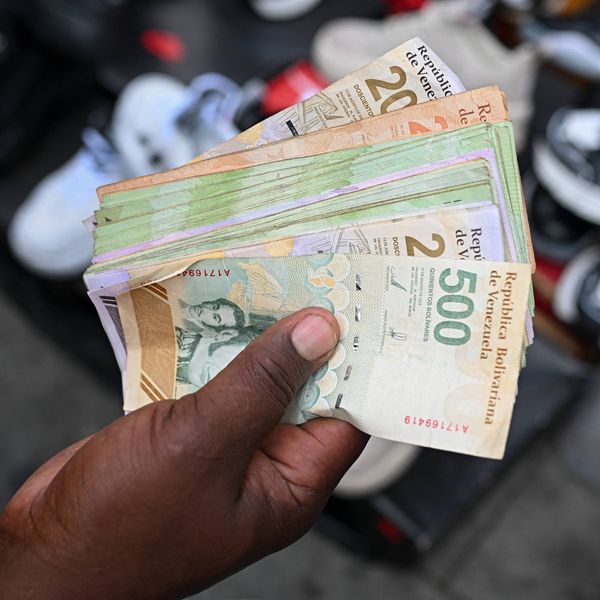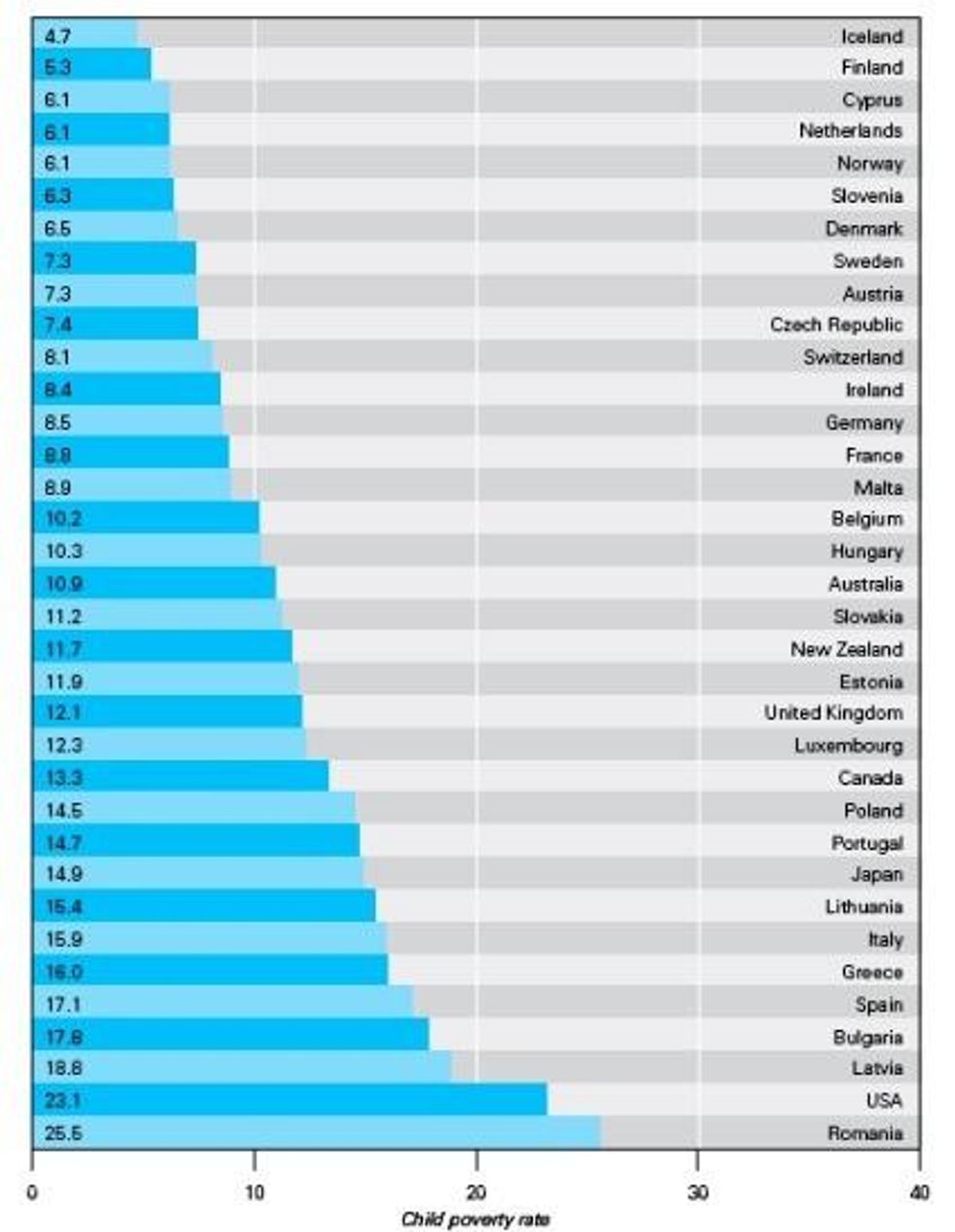UNICEF: US Among Highest Child Poverty Rates in Developed Countries
A new report released this week by the United Nations Children's Fund (UNICEF) reveals alarming child poverty rates within affluent, or 'developed', nations. The US ranks second highest among all measured countries, with 23.1 per cent of children living in poverty, just under Romania's 25.6 per cent.
The report Report Card 10 shows roughly 13 million children in the European Union (plus Norway and Iceland) lack basic items necessary for their development. 30 million children - across 35 countries with developed economies - live in poverty.
A new report released this week by the United Nations Children's Fund (UNICEF) reveals alarming child poverty rates within affluent, or 'developed', nations. The US ranks second highest among all measured countries, with 23.1 per cent of children living in poverty, just under Romania's 25.6 per cent.
The report Report Card 10 shows roughly 13 million children in the European Union (plus Norway and Iceland) lack basic items necessary for their development. 30 million children - across 35 countries with developed economies - live in poverty.
"The data reinforces that far too many children continue to go without the basics in countries that have the means to provide," said Gordon Alexander, Director of UNICEF's Office of Research.
* * *
UNICEF: Table of relative child poverty, 35 economically advanced countries
Figure shows the percentage of children (aged 0 to 17) who are living in relative poverty, defined as living in a household in which disposable income, when adjusted for family size and composition, is less than 50% of the national median income.
* * *
UNICEF: Tens of millions of children living in poverty in the world's richest countries
As debates rage on austerity measures and social spending cuts, a new report reveals the extent of child poverty and child deprivation in the world's advanced economies. Some 13 million children in the European Union (plus Norway and Iceland) lack basic items necessary for their development. Meanwhile, 30 million children - across 35 countries with developed economies - live in poverty.
Report Card 10, from UNICEF's Office of Research, looks at child poverty and child deprivation across the industrialized world, comparing and ranking countries' performance. This international comparison, says the Report, proves that child poverty in these countries is not inevitable, but policy susceptible - and that some countries are doing much better than others at protecting their most vulnerable children. [...]
In doing so UNICEF's Office of Research tries to estimate what percentage of children are falling significantly behind what can be considered normal for their own societies. [...]
"The report makes clear that some governments are doing much better at tackling child deprivation than others," said Mr Alexander. "The best performers show it is possible to address poverty within the current fiscal space. On the flip side, failure to protect children from today's economic crisis is one of the most costly mistakes a society can make."
# # #
An Urgent Message From Our Co-Founder
Dear Common Dreams reader, The U.S. is on a fast track to authoritarianism like nothing I've ever seen. Meanwhile, corporate news outlets are utterly capitulating to Trump, twisting their coverage to avoid drawing his ire while lining up to stuff cash in his pockets. That's why I believe that Common Dreams is doing the best and most consequential reporting that we've ever done. Our small but mighty team is a progressive reporting powerhouse, covering the news every day that the corporate media never will. Our mission has always been simple: To inform. To inspire. And to ignite change for the common good. Now here's the key piece that I want all our readers to understand: None of this would be possible without your financial support. That's not just some fundraising cliche. It's the absolute and literal truth. We don't accept corporate advertising and never will. We don't have a paywall because we don't think people should be blocked from critical news based on their ability to pay. Everything we do is funded by the donations of readers like you. Will you donate now to help power the nonprofit, independent reporting of Common Dreams? Thank you for being a vital member of our community. Together, we can keep independent journalism alive when it’s needed most. - Craig Brown, Co-founder |
A new report released this week by the United Nations Children's Fund (UNICEF) reveals alarming child poverty rates within affluent, or 'developed', nations. The US ranks second highest among all measured countries, with 23.1 per cent of children living in poverty, just under Romania's 25.6 per cent.
The report Report Card 10 shows roughly 13 million children in the European Union (plus Norway and Iceland) lack basic items necessary for their development. 30 million children - across 35 countries with developed economies - live in poverty.
"The data reinforces that far too many children continue to go without the basics in countries that have the means to provide," said Gordon Alexander, Director of UNICEF's Office of Research.
* * *
UNICEF: Table of relative child poverty, 35 economically advanced countries
Figure shows the percentage of children (aged 0 to 17) who are living in relative poverty, defined as living in a household in which disposable income, when adjusted for family size and composition, is less than 50% of the national median income.
* * *
UNICEF: Tens of millions of children living in poverty in the world's richest countries
As debates rage on austerity measures and social spending cuts, a new report reveals the extent of child poverty and child deprivation in the world's advanced economies. Some 13 million children in the European Union (plus Norway and Iceland) lack basic items necessary for their development. Meanwhile, 30 million children - across 35 countries with developed economies - live in poverty.
Report Card 10, from UNICEF's Office of Research, looks at child poverty and child deprivation across the industrialized world, comparing and ranking countries' performance. This international comparison, says the Report, proves that child poverty in these countries is not inevitable, but policy susceptible - and that some countries are doing much better than others at protecting their most vulnerable children. [...]
In doing so UNICEF's Office of Research tries to estimate what percentage of children are falling significantly behind what can be considered normal for their own societies. [...]
"The report makes clear that some governments are doing much better at tackling child deprivation than others," said Mr Alexander. "The best performers show it is possible to address poverty within the current fiscal space. On the flip side, failure to protect children from today's economic crisis is one of the most costly mistakes a society can make."
# # #
A new report released this week by the United Nations Children's Fund (UNICEF) reveals alarming child poverty rates within affluent, or 'developed', nations. The US ranks second highest among all measured countries, with 23.1 per cent of children living in poverty, just under Romania's 25.6 per cent.
The report Report Card 10 shows roughly 13 million children in the European Union (plus Norway and Iceland) lack basic items necessary for their development. 30 million children - across 35 countries with developed economies - live in poverty.
"The data reinforces that far too many children continue to go without the basics in countries that have the means to provide," said Gordon Alexander, Director of UNICEF's Office of Research.
* * *
UNICEF: Table of relative child poverty, 35 economically advanced countries
Figure shows the percentage of children (aged 0 to 17) who are living in relative poverty, defined as living in a household in which disposable income, when adjusted for family size and composition, is less than 50% of the national median income.
* * *
UNICEF: Tens of millions of children living in poverty in the world's richest countries
As debates rage on austerity measures and social spending cuts, a new report reveals the extent of child poverty and child deprivation in the world's advanced economies. Some 13 million children in the European Union (plus Norway and Iceland) lack basic items necessary for their development. Meanwhile, 30 million children - across 35 countries with developed economies - live in poverty.
Report Card 10, from UNICEF's Office of Research, looks at child poverty and child deprivation across the industrialized world, comparing and ranking countries' performance. This international comparison, says the Report, proves that child poverty in these countries is not inevitable, but policy susceptible - and that some countries are doing much better than others at protecting their most vulnerable children. [...]
In doing so UNICEF's Office of Research tries to estimate what percentage of children are falling significantly behind what can be considered normal for their own societies. [...]
"The report makes clear that some governments are doing much better at tackling child deprivation than others," said Mr Alexander. "The best performers show it is possible to address poverty within the current fiscal space. On the flip side, failure to protect children from today's economic crisis is one of the most costly mistakes a society can make."
# # #


